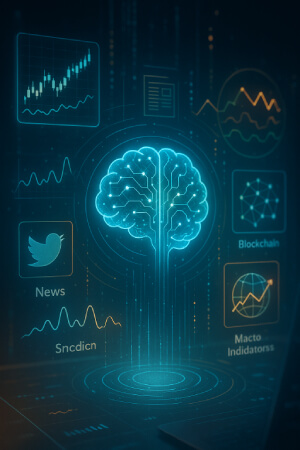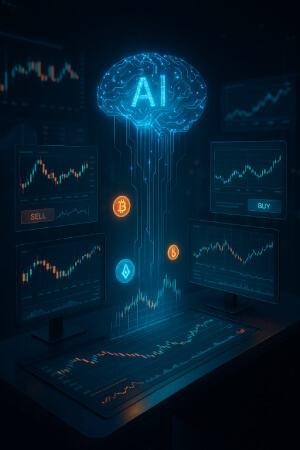What Is AI Crypto Trading?

AI crypto trading refers to systems that use artificial intelligence to examine the market situation and execute buy or sell orders automatically. Traditional traders depend on experience, analysis, and instinct. AI algorithms, however, take in vast volumes of historical and live data with due diligence and execute based on data generated algorithms on time.
At the heart of AI trading are machine learning, pattern recognition, and predictive analytics. The system makes an assessment out of several thousand variables, including price movements, sentiment trends, and trading volumes, within a few milliseconds.
Generally, AI trading systems would go through numerous interconnected layers:
- Data Collection: Real-time and historical market data, contextual inputs such as news, or sentiments on social media.
- Machine Learning Models: Helping to analyze intricate relationships and identify patterns that have predictive power.
- Predictive Analytics: Forecasting short-term and long-term market trend.
- Automated execution: the trade is placed on the market automatically upon an algorithmic opinion.
Each side of this trinity supports the others, thus enabling the system to learn from experience and adapt to changing market conditions.
How Machine Learning Makes Its Way Into Market Decisions
Machine learning takes center stage in AI trading, feeding and nourishing competition and evolution among algorithms. The algorithms concentrate on the betterment of themselves through data, much in the same fashion an intuitive trader gains through experience. With this flexibility, AI can build patterns and detect signals beyond the perception of the naked eye, thereby responding with strategy as the circumstances evolve in the market.
Pattern Recognition
Models are far superior to humans in recognition of recurring structures of historical price data when such forms reflect trends, cycles, or correlations between assets. For instance, an algorithm might infer that a spike in Bitcoin trading volume will forecast a short-term price increase. With this knowledge, the system can undertake future trades with adjustments optimizing timing and scale for better results.
Predictive Analytics
Predictive analytics enable AI systems to forecast price movements based on special statistical and probabilistic models that include:
- Regression Models: Attempting to quantify the potential price trends over time.
- Classification Models: Attempting to quantify some kind of likelihood of price going up or down.
- Time Series Analysis: Analyzing sequential data with an eye toward projecting for the future.
By integrating several kinds of analyses, AI systems can project more reasonable forecasts and provide probabilities useful to traders, rather than hard statements with only one prediction.
Data Sources and Market Signals

AI trading does not depend on price charts alone. Numerous signals give the system a wider picture of market conditions:
- Market Data: Prices, order-book depth, and trading volumes.
- News and Social Media: Instantaneous sentiment extracted from articles, posts, and discussions.
- Block Chain Metrics: Various on-chain activities representing wallet transactions, flows of tokens, etc.
- Macro Indicators: interest rates, regulatory updates, and general economic data.
Once these sources are brought together, AI systems can craft a multidimensional picture of market behavior, which then in turn informs short-term trading as well as long-term strategies.
Sentiment Analysis
Public perception moves markets in lightning-fast times in the crypto space, therein lies the potency of sentiment analysis. The AI-powered tools analyze immense amounts of language data, tweets, forum posts, and headlines to determine whether the overall sentiment is positive, negative, or neutral.
An abrupt surge in the negative sentiment of a specific coin might mean that its price will fall, while new optimism might precede a rise. As AI customizes this sentiment data against real-time trading data, it becomes capable of further sharpening its prediction and overtaking human analysts in decision-making speed.
Types of AI Trading Strategies
Several modes of AI crypto trading can function as a viable strategy, in various instances and for various conditions, according to the level of risk.
Trend Following
This strategy aims for sustained price movement, upward or downward, thus it trades with the trend. AI-powered systems are constantly observing the major market indicators, analyzing price data and volumes, as well as technical signals to discern the incipient trends. Machine learning further refines such precision by detecting subtle changes in volatility or trading activity that might escape the attention of a human trader. Once entry and exit timing is automated, emotional decision-making is greatly minimized, ensuring consistency in execution. This particular blend of real-time monitoring, insight from data, and automated response capacity allows the trader to efficiently ride the trend with proper risk oversight.
Mean Reversion
Generally based on the mean-reversion principle, asset prices will tend to return to their past averages over time. AI systems keep tracking price movements to detect any wide deviation of an asset from its normal range. Historically speaking, algorithms evaluate the data of the asset's price, volatility patterns, and market sentiment to forecast reversals with higher likelihood of taking place. After that, on an automated basis, the trades are executed immediately whenever an opportunity arises so that the system can profit from these predictable ebbs. In the most volatile markets, mean-reversion AI strategies help preempt gains and at the same time keep them at a relatively low level of exposure to extended price swings-a disciplined, data-driven trading approach.
Arbitrage
Arbitrage attempts to exploit short-term price differences for the very same asset in different exchanges. AI tends to be very good at this. It scans numerous markets in real-time for price differences and executes trades immediately. Since success depends on speed and accuracy, delays from human intervention are eliminated by automatic systems, and the risk that a manual arbitrage attempt will fail due to some human error is reduced. By rapidly analyzing data and executing orders accurately, AI guarantees that no opportunity for arbitrage will be lost. This makes arbitrage a potent instrument for monopolizing fleeting market inefficiencies while simultaneously ensuring that the exposure to risk is kept to a minimum amid the frenzy that characterizes the cryptocurrency markets.
Momentum Trading
Momentum trading targets assets currently undergoing strong directional movement, keeping an eye on continuing trends before their impending reversal. AI will make this strategy even stronger by continuously observing momentum indicators, price accelerations, trading volumes, and historical patterns. Instant data-processing at such huge levels enables the detection of delicate signals that may pass under the radar of human traders, thereby leading to very fast and highly consistent decision-making. Automation allows a timely entry or exit from a trade while removing emotional bias to an extent from the execution of trades. In that manner, traders can now efficiently ride on the momentum of the ever-changing markets with risk management in effect and minimal exposure to sudden reversals.
Automated Order Execution

Automation is what makes AI strategies operative. As soon as my systems service identifies an opportunity, different trades can be carried out immediately, with zero human confirmation required. This completely erases reaction lag and gives 24-7 operational efficiency in global crypto markets.
Automated execution also comes with an integrated safety precaution. Stop-loss and take-profit orders can be programmed for locking in profits or cutting losses. This elegant combination of speed plus discipline may keep AI maintaining risk control even during fast-moving markets.
Risk Management in AI Trading
Risk management comes embedded at every step in AI trading. Here, algorithms continuously evaluate volatility, portfolio exposure, and potential loss situations. Examples include:
- Stop-Loss Orders: Automatically sells when an asset drops to a particular level.
- Position Sizing: Adjusts size of a trade depending on volatility and confidence.
- Diversification: Spreads exposure over multiple assets to lessen concentration risk.
Being AI means being able to function 24 hours a day to rebalance or hedge against real-time events and something humans will never be able to accomplish.
How AI Learns and Improves Over Time
In an AI trading system, evolution takes place upon feedback and data. Markets shift and along with it algorithms retrain themselves based on new information, becoming more accurate in their prediction, and adapt to new forms of behavior.
Reinforcement Learning
Reinforcement learning is a type of machine learning where trading algorithms improve by trial and error. Each trade provides feedback, either in the form of profit or loss; the system uses this feedback to modify its subsequent decision. The more the process repeats, the more the model identifies actions that lead to desired outcomes and it evolves based on these actions. This way, the algorithm becomes better with time, making fewer mistakes and improving in overall efficiency. Reinforcement learning enables an AI-based trading system to adapt to ever-changing environments and improve its decision-making ability in both volatile and steady markets through its continuous interaction with the market.
Backtesting and Simulation
AI trading strategies undergo thorough backtesting with historical market data, ranging from inception to the very last moment, to be deployed live. Thus, backtesting presents a picture of the potential performance of a strategy under past market conditions, which brings out its pluses and minuses. Simulation environments, on the other hand, place the strategy in hypothetical situations where it is confronted with scenarios of extreme volatility or rare events without actually risking capital: Backtesting and simulation together are what helps in refining and optimizing the algorithms so that they behave well and in an expected manner under a wide range of varying conditions. Thus, these steps identify loopholes and improve decision-making before going live, enabling them to uphold the reliability and robustness of AI trading strategies.
Limitations and Challenges
Certain limitations inherent to AI trading are given below:
- Market Unpredictability: Sudden changes, like a shift in regulations, an instance of hackers attacking computer systems, or macroeconomic shocks, can still face such models and can way out be cast by considered most advanced.
- Overfitting: Algorithms may perform well in the historical setting while struggling to function in changing environments.
- Data Quality: Partial or inaccurate data leads to malfunction.
- Technical Failures: Interruption of trading session due to connectivity error or system error.
Acknowledge these risks to set trading expectations in place and use AI as an adjunct to human oversight and not as a substitution.
Future of AI in Crypto Trading
The AI has been growing towards trading adaptability and transparency. Explainable AI is making algorithms simpler for people by allowing the user to review algorithm decisions and instill trust. Integration with DeFi is paving the way for automated trading across new protocols.
By then, superior sentiment analysis would include voice and video and multimedia cues, thereby mapping with a little deeper feature into market mood. Algorithms that adapt dynamically to market structures are also appearing, signaling the initiation of intelligent responsive trading systems.
The AI Advantage
In the domain of crypto-trading AI uses machine learning, predictive modeling, and automated execution mainly for producing speed, consistency, and insight. AI-based and analyzed systems study real-time market data, along with sentiment and blockchain signals, with the major objective of removing emotional bias from trading and for time-spotting opportunities that an average trader could occasionally miss. AI nowadays has become one real-time equal to trafficking in digital assets.
Quick Links
💻 AI is reshaping crypto trading with bots analyzing real-time data better than humans. Automated portfolios are the future for quick decisions. #CryptoBots #AITrading #CryptoAutomation 🤖 pic.twitter.com/GIQjMAi5wJ
— Wirer 💓 (@wirer_w) November 10, 2025
🚨BREAKING: AI can now replace an entire trading team worth $300K.
— Hasan Toor (@hasantoxr) July 24, 2025
It scans markets 24/7, runs strategies, and executes faster than any human.
Here’s how it works👇 pic.twitter.com/q43JVp5ZsW
🚨BREAKING: AI can now replace an entire trading team worth $300K.
— Hasan Toor (@hasantoxr) July 24, 2025
It scans markets 24/7, runs strategies, and executes faster than any human.
Here’s how it works👇 pic.twitter.com/q43JVp5ZsW